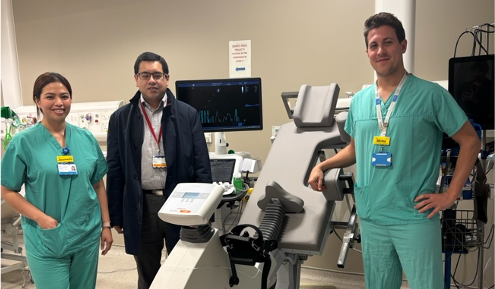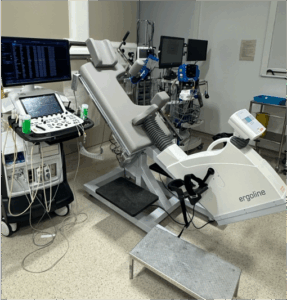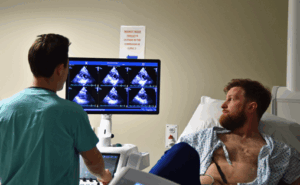Cycling for a Diagnosis

May 22nd, 2025
The Guild has awarded a substantial grant towards the cost of an exercise stress echocardiography bicycle.
Dr Sanjeev Bhattacharyya, Consultant Cardiologist and Clinical Lead Echocardiography at St Bartholomew’s Hospital & University College London Hospital, describes how this new more comfortable machine provides a ‘one stop shop’ for rapid diagnosis.
This bicycle will be an integral part of our stress echocardiography service which performs 1,500 – 2,000 studies per year. We are a national centre, leading innovation in stress echocardiography practice in the United Kingdom and organise a range of courses to help other centres develop their own services. Several research fellows have completed higher research degrees centred on clinical applications of stress echocardiography. We are very grateful to Barts Guild for contributing to this purchase, which will enable us to continue to build and expand our service.

Photographs: Neil Ritson
Stress echocardiography offers a unique method to identify the cause of breathlessness or chest pain. The stress echocardiography bicycle is an upright, fixed bicycle with graded resistance which gradually increases. Patients cycle on the bike until symptomatic with breathlessness or chest pain or until they reach a defined heart rate. Echocardiography to assess a patient’s heart valves, heart muscle and blood flow to the heart arteries using ultrasound, is performed simultaneously both at rest and during the test.
Additional information can be obtained by combining the test with cardiopulmonary exercise testing, where patients breathe through a facemask which measures the amount of oxygen and carbon dioxide in the air they exhale as well as how much air their lungs can take in. This allows us to identify whether a patient’s symptoms are due to a primary lung or heart problem.
 The new bicycle is very ergonomic with adjustable frames and pedals which makes it very comfortable compared to our old equipment, where a proportion of patients were unable to perform the test due to the lack of adjustable features and discomfort. In addition, it integrates seamlessly with our echocardiography and cardiopulmonary exercise test machines, allowing the creation of an integrated report at the end of the test. The test is commonly used in the following situations.
The new bicycle is very ergonomic with adjustable frames and pedals which makes it very comfortable compared to our old equipment, where a proportion of patients were unable to perform the test due to the lack of adjustable features and discomfort. In addition, it integrates seamlessly with our echocardiography and cardiopulmonary exercise test machines, allowing the creation of an integrated report at the end of the test. The test is commonly used in the following situations.
Coronary Artery Disease: In patients with narrowed arteries of the heart (coronary artery disease), the resting function of the heart may be normal. However, with exercise, the areas of the heart supplied by the narrowed artery will contract less vigorously. This characteristic change can be seen when comparing the images of the heart obtained at rest and during exercise. Identifying narrowed arteries, after confirmation by an invasive test, will lead to medication and sometimes a stent to improve blood flow and, consequently, patients’ symptoms.
Heart Valve Disease: Patients with severely narrowed (aortic/mitral stenosis) or leaking heart valves (mitral regurgitation) often notice a slowing down in activity without overt breathlessness. The exercise stress echo allows us to objectively test exercise capacity to determine whether they have symptoms on exertion or are truly asymptomatic. This helps us determine whether a valve intervention such as heart valve surgery would be beneficial. Some patients have non-severe valve disease at rest. However, they are symptomatic with breathlessness. There can be dynamic changes in the severity or the haemodynamic impact of valve disease during exercise. Exercise stress echocardiography can quantify changes in valve severity and quantify the haemodynamic impact on the heart both at rest and exercise. This allows us to determine whether a valve replacement or repair surgery would improve their symptoms.
Heart Muscle Disease: Patients with thickened heart muscle (hypertrophic cardiomyopathy) can develop partial obstruction to blood flow out of the heart. This can be measured at rest using echocardiography. However, in a proportion of patients there is no obstruction at rest despite the patient being breathless. During exercise stress echocardiography we can measure the degree of obstruction at rest and exercise. Where obstruction during exercise is identified, medical therapies to reduce the degree of obstruction and improve symptoms can be initiated.
 Cardiopulmonary stress echocardiography is only performed at a few centres in the UK. We are the only service in North-East and North-Central London. The equipment will allow more patients to access this state of art service. It will also allow us to train more healthcare staff from across the UK to perform cardiopulmonary exercise stress echo and therefore have wider impact and benefit.
Cardiopulmonary stress echocardiography is only performed at a few centres in the UK. We are the only service in North-East and North-Central London. The equipment will allow more patients to access this state of art service. It will also allow us to train more healthcare staff from across the UK to perform cardiopulmonary exercise stress echo and therefore have wider impact and benefit.
Barts Guild has designated this award as the 2025 Lorna Glace Memorial Grant, in memory of our friend who passed away in January 2021. Lorna was a valued Guild volunteer, and was a patient of Barts Heart Centre.
This article first appeared in Issue 25 (May 2025) of Barts Guild News, which is available to download from our Publications page, together with all previous issues.
